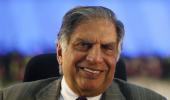In a December 2012 interview, Ratan Tata, then preparing to step down as chairman of Tata Sons, expressed doubts about the Tata group re-entering the aviation sector, calling it a space plagued by “destructive competition”.

But beneath that frustration lay nearly two decades of failed attempts to conquer the Indian skies.
In 1994, Tata, along with Singapore Airlines, had plans to launch a joint venture (JV) airline in India.
However, fierce opposition from politicians, bureaucrats, and rival airlines to the idea of a foreign firm holding a majority stake in an Indian carrier derailed the dream.
Tata restructured the deal to ease concerns, the then Union government reportedly killed the proposal.
In a speech in 2010, Tata revealed how deeply this ordeal affected him.
He recalled being on a flight in the late 1990s when “another industrialist who was sitting next to me said, ‘I don’t understand... you people are very stupid... you know the minister wants (Rs )15 crore... why don’t you pay it?”
Tata’s response was firm: “I just said, ‘You can’t understand it... I just want to go to bed at night knowing that I haven’t got the airline by paying for it’.
"And I can tell you, I would have felt tremendously ashamed had we gotten the airline by paying for it.”
The story repeated itself in 2001 when the BJP-led government put up a 40 per cent stake in Air India for sale.
Tata, again partnering with Singapore Airlines, was the sole bidder.
Resistance from labour unions and rival airlines thwarted the deal.
However, his passion for aviation remained unshakable, exemplified by his pilot licence and the fact that he co-piloted an F-16 Falcon combat aircraft in 2007.
Just two months after expressing doubt in 2012, the group announced a JV with Malaysia’s AirAsia to launch a new low-cost airline — AirAsia India.
In 2013, Tata once again joined hands with Singapore Airlines to launch Vistara, a premium full-service airline.
Even in retirement, his aviation ambitions were anything but grounded.
In 2022, in a move that marked a full circle, the Tata group acquired Air India — the very airline that J R D Tata had founded as Tata Airlines in 1932, which was nationalised by the government in 1953.
With its combined airlines, the Tata group is now the second-largest player in the Indian market, commanding nearly 30 per cent of the domestic market share.
AirAsia India has been merged into Air India Express, and with Vistara set to merge into Air India next month, Air India is poised to become an aviation giant.
It is a behemoth that Ratan Tata had always envisioned — an airline empire that will dominate Indian skies, just as J R D once did.
The “destructive competition” Ratan Tata once warned about has all but faded.
Airfares have stabilised, and the Indian aviation market has consolidated into a more manageable playing field with just four major carriers.
Two of them — IndiGo and the Air India Group — now control over 90 per cent of the market share.












 © 2025
© 2025